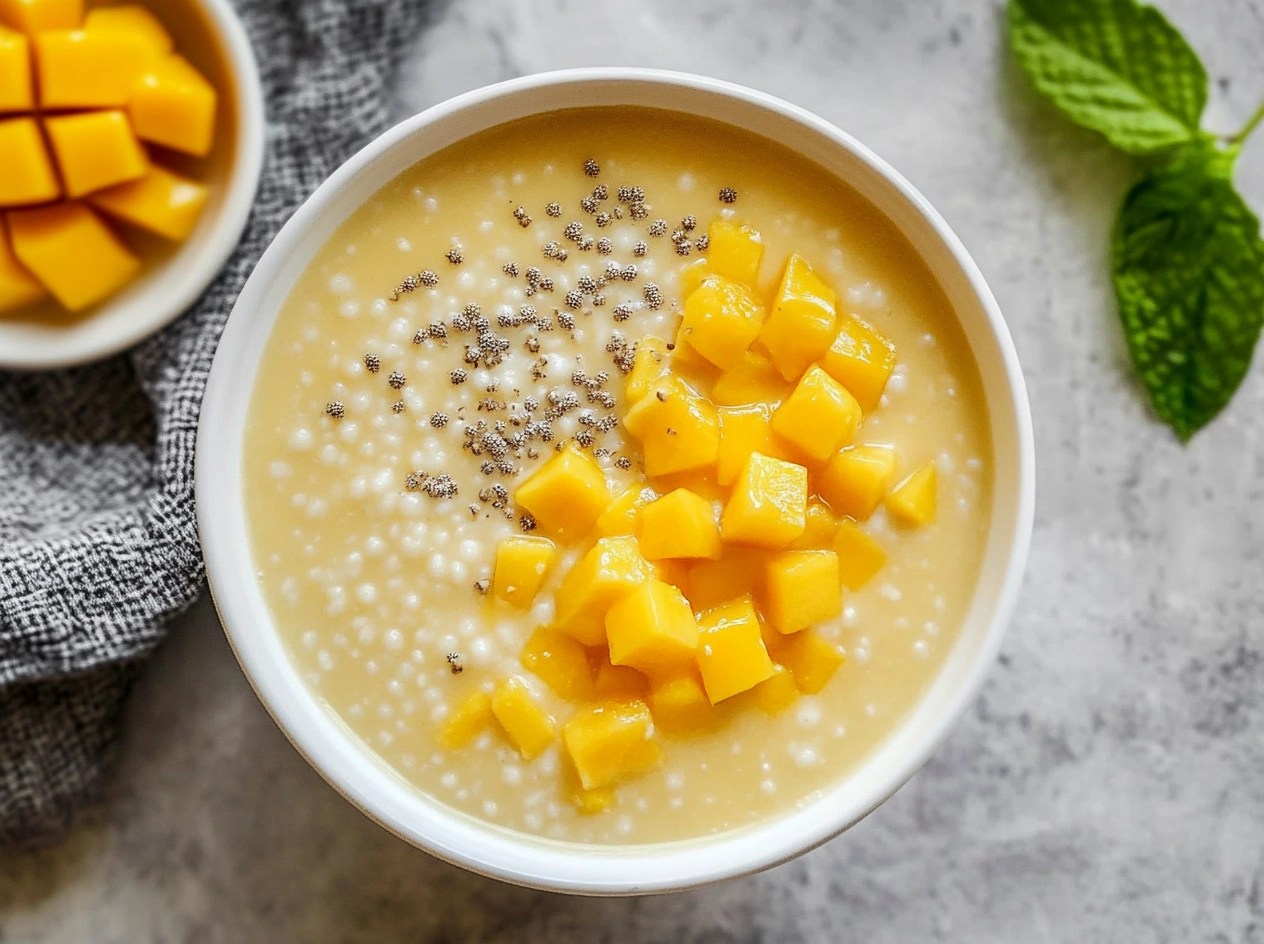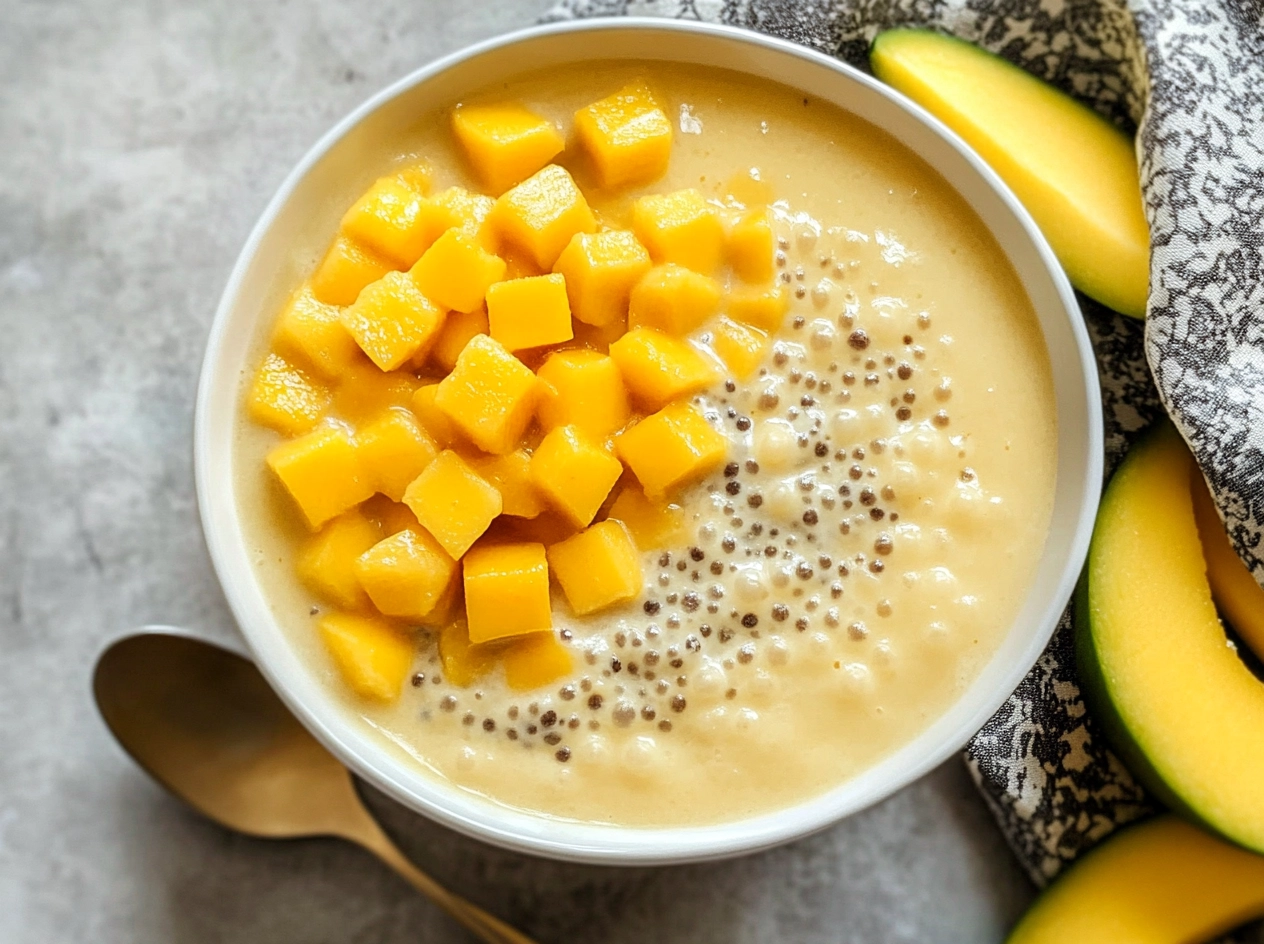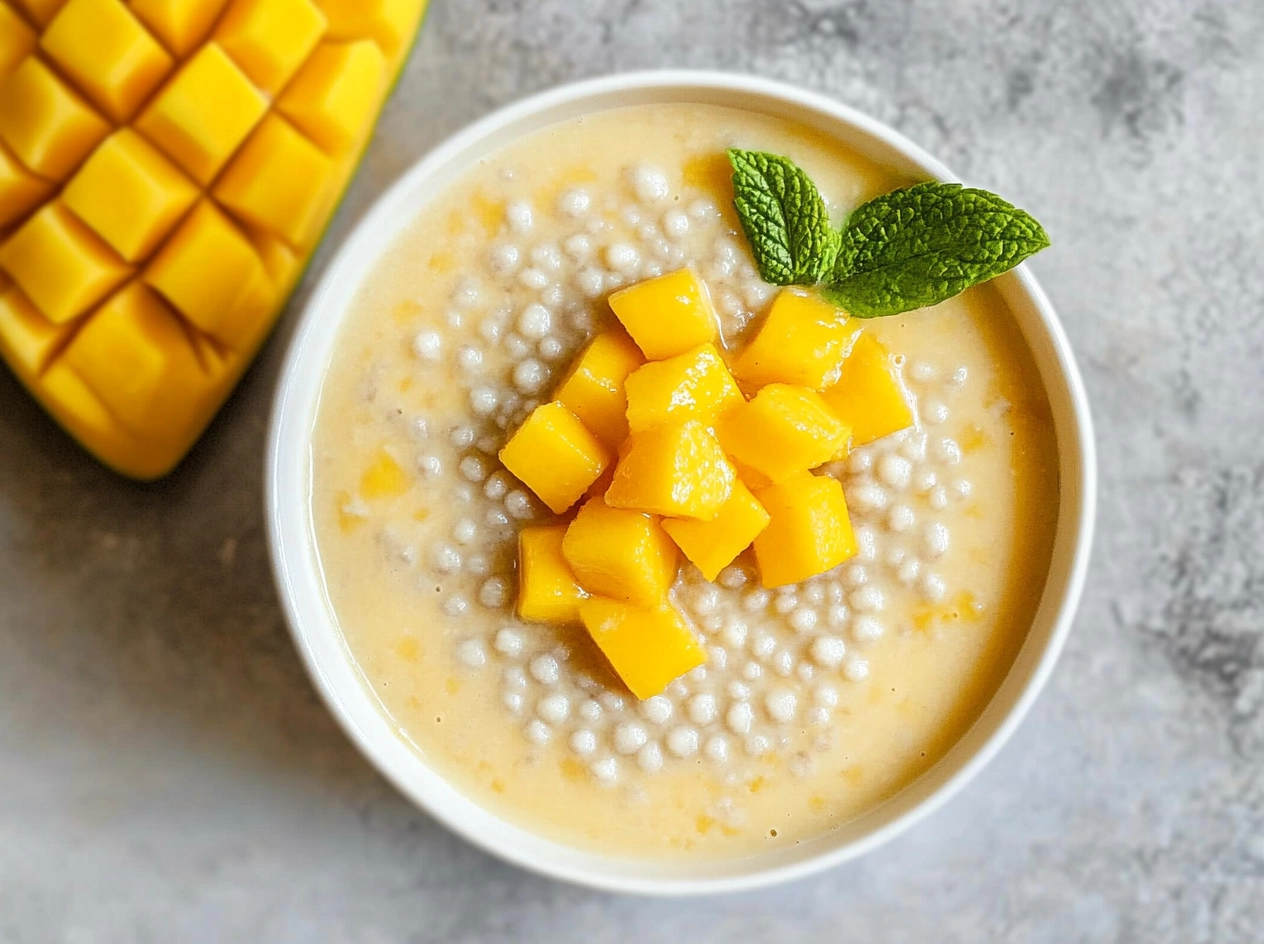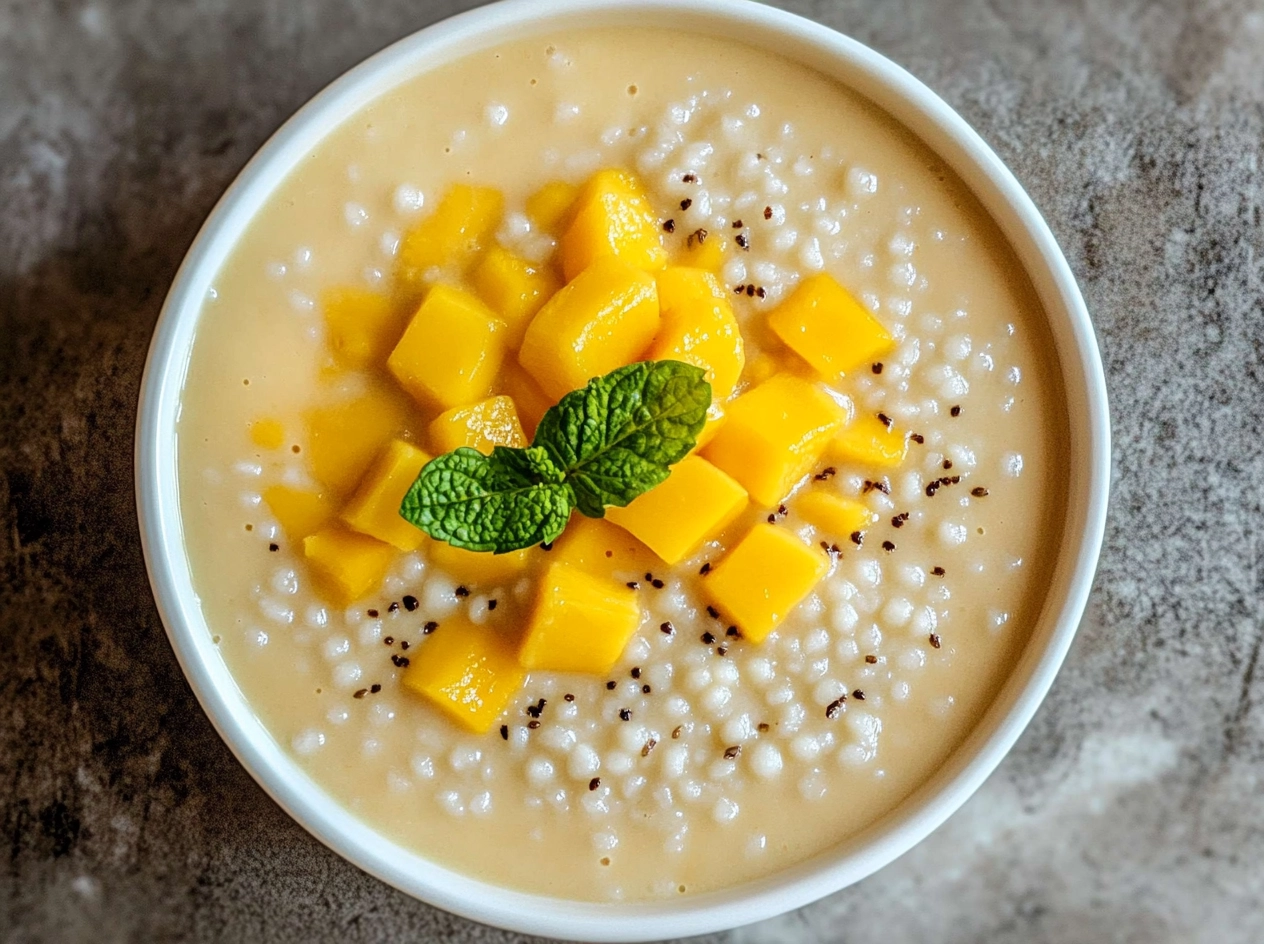MANGO SAGO


What is Mango Sago?
Mango Sago is an incredibly popular dessert originating from Southeast Asia, celebrated for its delightful interplay of flavors and textures. This creamy and refreshing treat combines sweet mango puree with chewy sago pearls and is often enriched with coconut milk for added creaminess. It’s a dessert that not only satisfies your sweet tooth but also offers a tropical escape, making it perfect for warm days.
Origin and Popularity of Mango Sago
The roots of Mango Sago can be traced back to Hong Kong, where it gained massive popularity in the 1980s alongside the emergence of other Asian desserts. Its refreshing taste and pleasing presentation quickly made it a favorite among dessert lovers. Today, it’s a staple in many Asian dessert shops and restaurants but has also found a home in kitchens worldwide, where home cooks strive to recreate its delightful flavors.
Benefits of Making Mango Sago at Home
Making Mango Sago at home has numerous benefits:
- Fresh Ingredients: You control the quality and freshness of all ingredients.
- Customization: Tailor the sweetness and texture to your liking.
- Healthier Options: Use natural ingredients and adjust the sugar content.
- Cost-Efficient: Prepare this delicious dessert without the markup of restaurants.
Importance of Main Ingredients
Value of Mango in the Recipe
Mangoes are the star of Mango Sago. This tropical fruit is not only delicious but also rich in vitamins such as A, C, and E, along with fiber and antioxidants. Choosing ripe, sweet mangoes elevates the dish and delivers the signature sweet and tangy flavor balance that defines Mango Sago. The lush, golden color of ripe mango puree enhances the visual appeal of the dessert, making it even more tempting.
Role of Sago in the Dish
Sago pearls are crucial in providing that characteristic chewy texture that contrasts beautifully with the smooth mango puree. These small, translucent pearls derived from the sago palm create a unique mouthfeel that can be both fun and satisfying. Additionally, sago is gluten-free and offers a source of carbohydrates, allowing even those with dietary restrictions to indulge in this delightful dessert.
The Vitality of Coconut Milk and Condensed Milk
Using both coconut milk and condensed milk in Mango Sago adds a luxurious creaminess and depth of flavor. Coconut milk not only provides healthy fats but also contributes a subtle sweetness and aroma that complements mango beautifully. Meanwhile, condensed milk introduces a rich sweetness, creating a well-rounded dessert that balances all the flavors beautifully. Together, they transform the dessert into a luscious and indulgent experience.
Necessary Tools and Safety Measures
Kitchen Tools Required
Before diving into this delicious recipe, make sure you have the right tools at your disposal:
- Medium-sized pot: For cooking the sago.
- Mixing bowl: To combine the mango puree and coconut milk.
- Measuring cups: For precise ingredient measurements.
- Blender: To puree the mangoes seamlessly.
- Serving cups or bowls: To serve your finished dessert.
Ensuring Safe Handling and Preparation of Ingredients
When it comes to food preparation, cleanliness is key. Here are some safety measures to follow:
- Always wash your hands before handling any food.
- Clean the kitchen surfaces and utensils regularly.
- Store ingredients like coconut milk and sago pearls in a cool and dry place.
- Inspect mangoes for ripeness before purchasing to ensure you are using the freshest fruit.
Ingredients List
Necessary Ingredients for Mango Sago
To prepare Mango Sago, you’ll need the following ingredients:
- 1 cup of sago pearls
- 2 ripe mangoes
- 1 cup of coconut milk
- ½ cup of sweetened condensed milk
- Water (for cooking sago)
- A pinch of salt
- Optional: Mango cubes for garnish
Selection and Measurement of Ingredients (US)
When measuring your ingredients, it’s essential to ensure accuracy, especially with sago and liquids, to achieve the desired texture and sweetness. Using a standard measuring cup will help with this. When selecting mangoes, choose those that are slightly soft when pressed but have no bruises.

Step-by-step Recipe Instruction
The Cooking Process of Sago
- Rinse the Sago Pearls: Start by rinsing 1 cup of sago pearls under cold water. This helps remove any excess starch.
- Boil the Water: In a medium pot, bring about 4 cups of water to a boil.
- Cook the Sago: Once the water is boiling, add the rinsed sago pearls. Reduce the heat to medium-low and cook for about 15-20 minutes, stirring occasionally. You’ll know the sago is done when the pearls turn translucent.
- Drain and Rinse: Once cooked, drain the sago pearls in a fine sieve and rinse them with cold water to stop the cooking process. Set aside to cool.
Preparation of Mango and Other Ingredients
- Prepare the Mangoes: While the sago is cooking, wash, peel, and chop 2 ripe mangoes into chunks.
- Blend the Mango: In a blender, puree 1 cup of the chopped mangoes until smooth. You can add a little water if needed for blending.
- Combine with Coconut Milk: In a mixing bowl, combine the mango puree with 1 cup of coconut milk and ½ cup of sweetened condensed milk. Mix until well combined.
Mixing and Combining The Ingredients
- Stir the Sago: Add the cooled sago pearls to the mixing bowl with the mango mixture.
- Add Salt: Stir in a pinch of salt to enhance the flavors.
- Taste Test: Adjust the sweetness by adding more condensed milk if desired.
Presentation and Serving Suggestions
To serve, scoop the Mango Sago into individual bowls or cups. You can top it with additional mango cubes for a pop of color and flavor.

Variation of Mango Sago (Optional Toppings or Add-ons)
Feel free to get creative with your toppings! Here are some suggestions:
- Fresh Fruits: Add sliced strawberries, kiwi, or other fruits.
- Dessicated Coconut: Sprinkle some on top for added texture.
- Mint Leaves: Garnish with fresh mint for a hint of freshness.
- Nuts: Chopped almonds or cashews can add a delightful crunch.
Tips and Tricks for Best Results
Choosing the Best Mangoes
Selecting mangoes that are perfectly ripe is essential for a delicious Mango Sago. Look for mangoes that are slightly soft to the touch and free from blemishes. Popular varieties like Alphonso or Haden are excellent choices for their sweetness and flavor.
Getting the Desired Texture for Sago
To achieve that ideal chewy texture, don’t overcook the sago pearls. Keep an eye on them while boiling, as they should take around 15-20 minutes to cook fully. Test a pearl after about 15 minutes to ensure it’s not overcooked.
Customizing the Sweetness Level
Taste your final mixture before serving. If you prefer it sweeter, feel free to add more condensed milk or even sugar, depending on your personal preference.
Common Mistakes While Making Mango Sago
Overcooking of Sago
One common misstep is overcooking the sago pearls, which can result in a mushy texture instead of the desired chewy bite. Stick to the recommended cooking time and test them for doneness.
Incorrect Ratios of Ingredients
Another frequent error is using incorrect ratios of mango to coconut milk and condensed milk. This can lead to an imbalance in flavor. Using one cup of each liquid ingredient is a great starting point for a creamy consistency without overpowering the mango taste.
Health Benefits and Nutrition Facts
Nutrients Going into Your Body with Mango Sago
Mango Sago is more than just a delightful dessert; it also carries a wealth of nutrients. Mangoes are loaded with vitamins A, C, and folate, while coconut milk contains medium-chain triglycerides, which can provide quick energy. Sago, being a carbohydrate, provides a boost of energy while keeping the dessert light and refreshing.
The Health Advantages of Mango Sago
In moderation, Mango Sago can be a healthier dessert option compared to traditional sweets, particularly without added chemical preservatives. The combination of fruits and coconut milk promotes hydration and nourishment. When enjoyed as a treat, it can add a cheerful note to a balanced diet.

Frequently Asked Questions
Can I use canned mango instead of fresh?
Yes! Using canned mango puree can save time. Just ensure that it’s unsweetened and pure mango without additional preservatives for the best flavor.
What if I don’t have sago? Could I substitute it with tapioca?
Absolutely! Tapioca pearls can be a great substitution if you can’t find sago. Insist on using small pearls for a similar texture.
How to store leftover Mango Sago? And for how long is it good?
Store leftover Mango Sago in an airtight container in the refrigerator. It’s best consumed within 2-3 days for optimal freshness. The sago may absorb moisture and change texture over time, so it’s best enjoyed fresh.
Encouraging Readers to Try Making the Recipe
Now that you have all the ingredients and instructions in hand, why not give Mango Sago a try? It’s a fun and rewarding cooking experience, and the end result is simply delightful. You’ll be surprised at how easy it is to whip up this tropical treat!
Sign-off line.
Happy cooking, and may each bowl of Mango Sago remind you of sunny days and sweet moments!
Print
MANGO SAGO
- Total Time: 35 minutes
- Yield: 4 servings 1x
- Diet: Vegetarian
Description
Mango Sago is a creamy and refreshing dessert made with sweet mango puree, chewy sago pearls, and coconut milk, perfect for warm days.
Ingredients
1 cup of sago pearls, 2 ripe mangoes, 1 cup of coconut milk, ½ cup of sweetened condensed milk, Water (for cooking sago), A pinch of salt, Optional: Mango cubes for garnish
Instructions
Rinse the sago pearls under cold water to remove excess starch., In a medium pot, bring about 4 cups of water to a boil., Add the rinsed sago pearls to the boiling water, reduce heat to medium-low, and cook for 15-20 minutes, stirring occasionally until the pearls turn translucent., Drain the cooked sago pearls in a fine sieve and rinse with cold water to stop the cooking process. Set aside to cool., While the sago is cooking, wash, peel, and chop the ripe mangoes into chunks., In a blender, puree 1 cup of the chopped mangoes until smooth, adding a little water if needed., In a mixing bowl, combine the mango puree with coconut milk and sweetened condensed milk, mixing until well combined., Add the cooled sago pearls to the mango mixture and stir in a pinch of salt to enhance flavors., Taste the mixture and adjust sweetness by adding more condensed milk if desired., Scoop the Mango Sago into individual bowls or cups and top with additional mango cubes for garnish.
Notes
Feel free to customize your Mango Sago with fresh fruits, desiccated coconut, mint leaves, or nuts for added texture and flavor.
- Prep Time: 15 minutes
- Cool Time: 0
- Cook Time: 20 minutes
- Category: Dessert
- Method: Cooking
- Cuisine: Southeast Asian
Nutrition
- Serving Size: 1 cup
- Calories: 250
- Sugar: 20g
- Sodium: 50mg
- Fat: 10g
- Saturated Fat: 8g
- Unsaturated Fat: 2g
- Trans Fat: 0g
- Carbohydrates: 35g
- Fiber: 2g
- Protein: 3g
- Cholesterol: 5mg
Keywords: Mango Sago, Dessert, Southeast Asian Dessert, Mango, Sago, Coconut Milk
